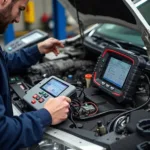Crafting a comprehensive Auto Repair Services Business Plan is crucial for anyone looking to turn their passion for cars into a profitable venture. This plan acts as a roadmap, guiding you through the initial stages of your business and providing a framework for long-term growth.
Key Elements of a Winning Auto Repair Services Business Plan
A well-structured business plan not only attracts investors but also helps you make informed decisions about your operations. Here’s a breakdown of the essential components:
1. Executive Summary
This section provides a concise overview of your entire business plan, highlighting the key points. Although it appears first, it’s best to write it last after you’ve fleshed out the other sections.
2. Company Description
Here, you’ll detail your auto repair shop’s identity. This includes:
- Business Name and Legal Structure: Choose a memorable name and decide on the legal structure that best suits your needs (sole proprietorship, partnership, LLC, etc.).
- Mission Statement: Clearly define your business’s purpose and what sets you apart from the competition.
- Services Offered: List all the auto repair services you plan to provide, from routine maintenance to specialized repairs.
 Auto Repair Services List
Auto Repair Services List
3. Market Analysis
Thorough market research is essential for understanding the competitive landscape.
- Target Market: Identify your ideal customer base. Are you targeting everyday car owners, businesses with fleet vehicles, or a niche market like classic car enthusiasts?
- Competitor Analysis: Research your competitors, their strengths, weaknesses, and pricing strategies. This will help you identify opportunities for differentiation.
- Industry Trends: Stay updated on the latest automotive technology and repair trends to ensure your services remain relevant and in demand.
4. Marketing and Sales Strategy
Outline your plan to reach your target audience and convert them into paying customers.
- Marketing Channels: Explore different marketing avenues like online advertising, social media marketing, local partnerships, and direct mail campaigns.
- Pricing Strategy: Determine your pricing structure, considering factors like labor costs, parts markup, and competitor pricing.
- Customer Retention: Develop strategies to encourage repeat business, such as loyalty programs and exceptional customer service.
5. Management and Operations
Provide a clear picture of your business’s operational structure.
- Management Team: Highlight the experience and expertise of your key personnel, including mechanics, service advisors, and managers.
- Facility and Equipment: Describe your workshop space, the equipment you’ll need, and any planned investments in advanced diagnostic tools.
- Inventory Management: Explain how you’ll manage your inventory of parts and supplies to ensure timely service delivery.
6. Financial Projections
Investors will want to see the financial viability of your venture.
- Startup Costs: Calculate all the initial expenses involved in launching your business, including equipment purchases, facility rent, and marketing costs.
- Revenue Projections: Estimate your projected income based on your service offerings, pricing, and anticipated customer volume.
- Profit and Loss, Cash Flow, Balance Sheet: Provide detailed financial statements demonstrating your understanding of the financial aspects of your business.
Additional Considerations for Success
While the core elements outlined above provide a strong foundation, consider these additional factors:
- Specialization: Focusing on a niche market, such as electric vehicle repair or classic car restoration, can help you stand out from the competition.
- Technology Adoption: Embrace technology by utilizing digital diagnostic tools, online booking systems, and customer relationship management (CRM) software.
- Sustainability: Incorporate eco-friendly practices into your operations, such as using recycled parts and properly disposing of hazardous materials.
Conclusion
Developing a comprehensive auto repair services business plan requires careful planning and research. By addressing each of the key elements outlined above, you can create a roadmap for success, attracting investors and guiding your business toward profitability and growth. Remember, your business plan is a living document that should be reviewed and updated regularly to reflect changing market conditions and your evolving business goals.
Frequently Asked Questions
1. How much does it cost to start an auto repair business?
Startup costs can vary widely depending on factors like location, size of the facility, and equipment needs. On average, expect to invest between $50,000 to $200,000.
2. What are the most profitable auto repair services?
Services like transmission repair, engine diagnostics, and collision repair tend to be more profitable due to their complexity and the specialized skills required.
3. How can I attract and retain qualified mechanics?
Offer competitive salaries, benefits, opportunities for professional development, and create a positive work environment.
4. What licenses and permits do I need to operate an auto repair shop?
Requirements vary by location, but you’ll likely need a business license, a seller’s permit, and potentially ASE certifications for your mechanics.
5. How can I market my auto repair business effectively?
Utilize a mix of online and offline marketing strategies, including local SEO, social media marketing, partnerships with car dealerships, and direct mail campaigns.
Need help getting your auto repair business off the ground? Explore our other resources:
Contact us today for expert advice and support! WhatsApp: +1(641)206-8880, Email: [email protected]. Our team is available 24/7 to assist you.

